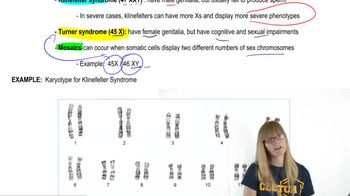In humans, the ABO blood type is under the control of autosomal multiple alleles. Color blindness is a recessive X-linked trait. If two parents who are both type A and have normal vision produce a son who is color-blind and is type O, what is the probability that their next child will be a female who has normal vision and is type O?
Table of contents
- 1. Introduction to Genetics51m
- 2. Mendel's Laws of Inheritance3h 37m
- 3. Extensions to Mendelian Inheritance2h 41m
- 4. Genetic Mapping and Linkage2h 28m
- 5. Genetics of Bacteria and Viruses1h 21m
- 6. Chromosomal Variation1h 48m
- 7. DNA and Chromosome Structure56m
- 8. DNA Replication1h 10m
- 9. Mitosis and Meiosis1h 34m
- 10. Transcription1h 0m
- 11. Translation58m
- 12. Gene Regulation in Prokaryotes1h 19m
- 13. Gene Regulation in Eukaryotes44m
- 14. Genetic Control of Development44m
- 15. Genomes and Genomics1h 50m
- 16. Transposable Elements47m
- 17. Mutation, Repair, and Recombination1h 6m
- 18. Molecular Genetic Tools19m
- 19. Cancer Genetics29m
- 20. Quantitative Genetics1h 26m
- 21. Population Genetics50m
- 22. Evolutionary Genetics29m
2. Mendel's Laws of Inheritance
Sex-Linked Genes
Problem 25
Textbook Question
In Drosophila, an X-linked recessive mutation, scalloped (sd), causes irregular wing margins. Diagram the F₁ and F₂ results if (a) a scalloped female is crossed with a normal male; (b) a scalloped male is crossed with a normal female. Compare these results with those that would be obtained if the scalloped gene were autosomal.
 Verified step by step guidance
Verified step by step guidance1
Step 1: Define the alleles and their inheritance pattern. Since the mutation 'scalloped (sd)' is X-linked recessive, denote the normal allele as X\^SD and the mutant allele as X\^sd. Males have one X and one Y chromosome (XY), females have two X chromosomes (XX). The mutant phenotype appears only when the recessive allele is present on all X chromosomes in females (X\^sd X\^sd) or on the single X chromosome in males (X\^sd Y).
Step 2: For cross (a), a scalloped female (X\^sd X\^sd) is crossed with a normal male (X\^SD Y). Set up the Punnett square for the F₁ generation by combining the female gametes (X\^sd) with the male gametes (X\^SD and Y). Determine the genotypes and phenotypes of the F₁ offspring, noting which are males and females and their wing phenotypes.
Step 3: For the F₂ generation in cross (a), cross the F₁ individuals among themselves (considering their genotypes from step 2). Set up Punnett squares for female and male offspring separately, and determine the expected genotypic and phenotypic ratios for both sexes.
Step 4: For cross (b), a scalloped male (X\^sd Y) is crossed with a normal female (X\^SD X\^SD). Set up the Punnett square for the F₁ generation by combining the male gametes (X\^sd and Y) with the female gametes (X\^SD). Determine the genotypes and phenotypes of the F₁ offspring.
Step 5: Compare the results from crosses (a) and (b) with the scenario where the scalloped gene is autosomal recessive. For autosomal inheritance, both males and females have two copies of the gene, so set up Punnett squares accordingly for each cross and note differences in phenotypic ratios and sex-specific expression.
 Verified video answer for a similar problem:
Verified video answer for a similar problem:This video solution was recommended by our tutors as helpful for the problem above
Video duration:
2mPlay a video:
Was this helpful?
Key Concepts
Here are the essential concepts you must grasp in order to answer the question correctly.
X-linked Recessive Inheritance
X-linked recessive traits are caused by mutations on the X chromosome and typically affect males more than females because males have only one X chromosome. Females must inherit two copies of the recessive allele to express the trait, while males express it if they inherit one mutated X. This pattern influences the phenotypic ratios in crosses involving sex chromosomes.
Recommended video:
Guided course

X-Inactivation
Sex Chromosome Inheritance in Drosophila
In Drosophila, females have two X chromosomes (XX) and males have one X and one Y chromosome (XY). Males inherit their X chromosome from their mother and Y from their father, while females inherit one X from each parent. This inheritance pattern affects how X-linked traits are passed and expressed in offspring.
Recommended video:
Guided course

Human Sex Chromosomes
Autosomal vs. Sex-linked Gene Inheritance
Autosomal genes are located on non-sex chromosomes and follow Mendelian inheritance with equal expression in both sexes. In contrast, sex-linked genes, like X-linked ones, show different inheritance patterns and phenotypic ratios between males and females. Comparing these patterns helps distinguish the chromosomal location of a gene.
Recommended video:
Guided course

Sex-Linked Genes
Related Videos
Related Practice
Textbook Question
1152
views


